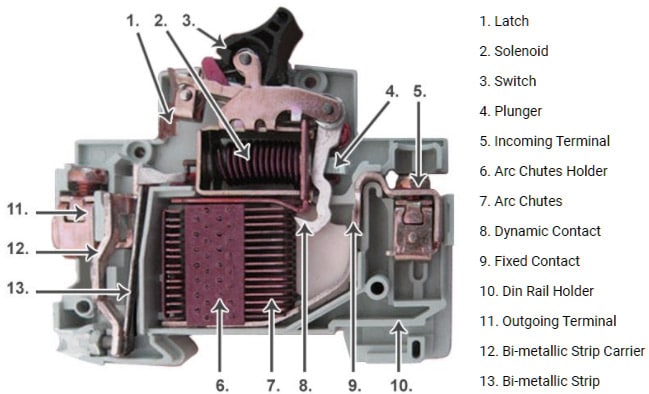A miniature circuit breaker (MCB) is an Electrical Switch that automatically switches off the electrical circuit during an abnormal condition of the network means an overload condition as well as a faulty condition.
Nowadays we use an MCB in a low-voltage electrical network instead of a fuse. The fuse may not sense it but the miniature circuit breaker does it in a more reliable way. MCB is much more sensitive to overcurrent than a fuse.
– Advertisement –

This is what an MCB looks like-

Handling an MCB is electrically safer than a fuse. Quick restoration of supply is possible in case of a fuse because fuses must be rewirable or replaced for restoring the supply. Restoration is easily possible by just switching it ON. Let’s look at the working of the miniature circuit breaker.
What is Inside Miniature Circuit Breaker?
A Miniature Circuit Breaker (MCB) typically consists of the following components:

- Incoming Terminal
- Outgoing Terminal
- Din Rail Holder
- Arc Chutes Holder
- Arc Chutes
- Fixed Contact
- Dynamic Contact
- Bi-metallic Strip Carrier
- Bi-metallic Strip
- Latch
- Plunger
- Solenoid
- Switch
Main contacts: These are the contacts that carry the load current and are connected to the incoming and outgoing wires of the circuit.
Trip Unit: This is the core component of an MCB, which monitors the current flowing through the circuit and trips the breaker in case of an over-current or short-circuit. The trip unit consists of a bimetallic strip, a magnetic actuator, and an operating mechanism.
Terminal: These are the connections for the incoming and outgoing wires.
Housing: The housing is the protective casing that houses the MCB components and provides insulation between live parts and other electrical components.
Trip Indicator: An MCB typically has a visual indicator that shows whether the breaker is in the “on” or “off” position.
Auxiliary contacts: Some MCBs have additional contacts that can be used to switch auxiliary loads or provide signaling functions.
Trip spring: This is the spring mechanism that holds the MCB contacts in the “on” position. When the trip unit operates, the trip spring releases, allowing the contacts to separate and break the circuit.